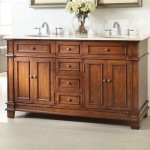What is a Sink in a Bathroom: A Comprehensive Overview
A sink in a bathroom, also commonly referred to as a washbasin, lavatory, or hand basin, is a plumbing fixture primarily used for washing hands, face, and other small items. It is a fundamental component of any functional bathroom, providing a designated space for hygiene and personal grooming. The design, materials, and installation of a bathroom sink can vary widely depending on aesthetic preferences, spatial constraints, and plumbing requirements.
The basic structure of a bathroom sink comprises a basin, a faucet (or tap), a drain, and often, an overflow mechanism. The basin is the receptacle that holds water temporarily. The faucet delivers hot and cold water, allowing the user to adjust the temperature. The drain allows the used water to flow away through the plumbing system. The overflow, typically a small hole near the top of the basin, prevents the sink from overflowing if the drain is blocked and the faucet is left running.
Beyond these essential components, the overall form and functionality of a bathroom sink are subject to considerable variation, influencing its suitability for different bathroom designs and user needs. Understanding the different types of bathroom sinks and their characteristics is crucial for making informed decisions during bathroom renovations or new construction projects.
Types of Bathroom Sinks
The market offers numerous types of bathroom sinks, each with its distinct installation method and aesthetic appeal. The appropriate choice relies on the desired style, available space, and budget. Common types include: vanity sinks, pedestal sinks, wall-mounted sinks, vessel sinks, and console sinks. Each has advantages and disadvantages.
Vanity Sinks: Vanity sinks are integrated into a cabinet or countertop, effectively combining the sink with storage space beneath. This design is highly practical, offering ample room for toiletries, cleaning supplies, and other bathroom essentials. Vanity sinks can be undermounted, drop-in (or self-rimming), or integrated, depending on the desired aesthetic and ease of cleaning. Undermounted sinks are installed beneath the countertop, creating a seamless and easy-to-clean surface. Drop-in sinks are placed into a pre-cut hole in the countertop and secured with a rim that rests on the surface. Integrated sinks are molded directly into the countertop material, creating a unified and seamless look.
Pedestal Sinks: Pedestal sinks consist of a basin supported by a freestanding pedestal. These sinks are a classic design choice, often used in bathrooms where space is limited or a minimalist aesthetic is desired. While pedestal sinks offer a clean and elegant appearance, they lack integrated storage, requiring alternative solutions for storing bathroom necessities. The pedestal conceals the plumbing, providing a neater appearance than a wall-mounted sink without a shroud.
Wall-Mounted Sinks: Wall-mounted sinks are attached directly to the wall, freeing up floor space and creating an open and airy feel. This type of sink is particularly well-suited for small bathrooms or powder rooms where maximizing space is a priority. Wall-mounted sinks require careful planning during installation to ensure adequate wall support for the weight of the sink and water. Because the plumbing is exposed, a decorative trap and supply lines are often used to enhance the aesthetic appeal. Alternatively, a shroud can be used to conceal the plumbing beneath the sink.
Vessel Sinks: Vessel sinks, also known as above-counter sinks, sit on top of the countertop rather than being recessed into it. These sinks are a popular choice for modern bathrooms, offering a distinctive and stylish look. Vessel sinks come in various shapes, sizes, and materials, allowing for significant design flexibility. The height of the countertop must be considered when choosing a vessel sink to ensure comfortable use. Faucets typically need to be taller to reach over the sink’s edge.
Console Sinks: Console sinks combine elements of both vanity and pedestal sinks. They feature a basin supported by legs, typically made of metal, providing a more open and airy look than a full vanity while still offering some storage space, often in the form of a shelf beneath the sink. Console sinks are a good option for those seeking a balance between aesthetics and functionality.
Materials Used in Bathroom Sinks
Bathroom sinks are manufactured from a variety of materials, each offering distinct properties in terms of durability, aesthetics, and maintenance requirements. Common materials include: vitreous china, porcelain, fireclay, cast iron, stainless steel, glass, stone, and acrylic.
Vitreous China: Vitreous china is a ceramic material that is coated with enamel and fired at high temperatures to create a durable, non-porous surface. It is a widely used material for bathroom sinks due to its resistance to stains, scratches, and chemicals. Vitreous china is relatively inexpensive and easy to clean, making it a practical choice for most bathrooms. However, it can be susceptible to chipping or cracking if subjected to significant impact.
Porcelain: Porcelain is another ceramic material similar to vitreous china but is generally more durable and less porous. It is made from finer clay and fired at higher temperatures, resulting in a harder and more resistant surface. Porcelain sinks are often more expensive than vitreous china sinks but offer greater longevity and resistance to wear and tear.
Fireclay: Fireclay is a type of ceramic material that is fired at extremely high temperatures, resulting in a particularly strong and durable sink. Fireclay sinks are resistant to heat, stains, and scratches, making them a good choice for high-use bathrooms. They tend to have a more rustic or handcrafted appearance than vitreous china or porcelain sinks.
Cast Iron: Cast iron sinks are made by pouring molten iron into a mold. They are then coated with a thick layer of enamel to create a smooth and durable surface. Cast iron sinks are extremely heavy and durable, offering excellent resistance to chipping and scratching. However, they are also more expensive and require stronger support structures due to their weight.
Stainless Steel: Stainless steel sinks are a popular choice for modern bathrooms due to their sleek and contemporary appearance. They are durable, rust-resistant, and easy to clean. Stainless steel sinks can be more prone to scratches and water spots than other materials, but regular cleaning can help maintain their appearance.
Glass: Glass sinks are a visually striking option, adding a touch of elegance to any bathroom. They can be made from clear, frosted, or colored glass and come in various shapes and sizes. Glass sinks require careful handling as they can be susceptible to chipping or cracking. They also tend to show water spots and require frequent cleaning to maintain their clarity.
Stone: Stone sinks, such as marble, granite, or travertine, offer a luxurious and natural look. Each stone sink is unique in its color and pattern. Stone sinks are porous and require sealing to prevent staining and water damage. They also tend to be more expensive and require heavier support structures due to their weight.
Acrylic: Acrylic sinks are made from a synthetic plastic material. They are lightweight, durable, and relatively inexpensive. Acrylic sinks are resistant to stains and scratches but can be susceptible to heat damage. They are available in a wide range of colors and styles.
Factors to Consider When Choosing a Bathroom Sink
Selecting the right bathroom sink involves considering several factors to ensure it meets both functional and aesthetic requirements. These factors include the size and layout of the bathroom, the desired style, the budget, and the plumbing configuration.
Bathroom Size and Layout: The size and layout of the bathroom are crucial determinants in choosing the appropriate sink. In small bathrooms, wall-mounted or pedestal sinks can help maximize floor space. In larger bathrooms, vanity sinks or console sinks can provide ample storage and counter space. The placement of the sink should allow for comfortable movement and accessibility.
Desired Style: The style of the bathroom sink should complement the overall design aesthetic of the bathroom. Modern bathrooms often feature sleek vessel sinks or stainless steel sinks, while traditional bathrooms may incorporate pedestal sinks or cast iron sinks. The choice of material, shape, and finish should align with the desired style.
Budget: Bathroom sinks range in price from relatively inexpensive vitreous china sinks to more expensive stone or cast iron sinks. Establishing a budget beforehand can help narrow down the options and ensure that the selected sink fits within the financial constraints of the project. Installation costs should also be factored into the budget.
Plumbing Configuration: The existing plumbing configuration can influence the choice of bathroom sink. Wall-mounted sinks require plumbing connections within the wall, while vanity sinks typically conceal the plumbing within the cabinet. Ensuring that the chosen sink is compatible with the existing plumbing system can simplify the installation process and avoid costly modifications.
Beyond these primary considerations, accessibility and user needs should also be taken into account. For individuals with mobility limitations, a wall-mounted sink with ample knee space underneath may be the most suitable option. The height of the sink should also be comfortable for all users. Attention to these details can ensure that the bathroom sink is both functional and user-friendly.

Bathroom Sinks Wash Basins Bathrooms Wickes

Bathroom Sinks Wash Basins Bathrooms Wickes

The Ultimate Guide To Bathroom Sinks And Basins R2 Bathrooms

What Are Diffe Types Of Bathroom Basins And Sinks City

Homeowner S Guide To Bathroom Sink Dimensions And Sizes The Family Handyman

The Ultimate Guide To Bathroom Sinks And Basins R2 Bathrooms

Types Of Bathroom Basin Drench

Sink Wikipedia

Bathroom Sink 101

Bathroom Sinks Thebath
Related Posts







